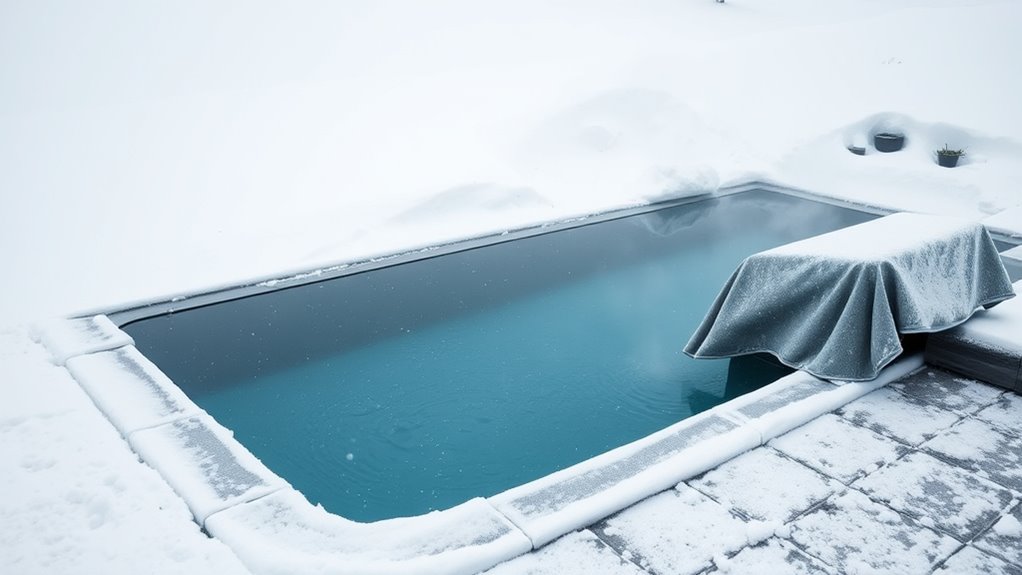To winterize your infinity pool’s trough, first turn off the pump and drain all water through drain plugs or a siphon, ensuring no residual water freezes and causes cracks. Protect plumbing by blowing out lines and adding antifreeze, then insulate edges with foam and seal cracks. Cover the trough securely and manage the water level to prevent damage. For detailed steps to safeguard your pool completely, continue exploring the essential precautions.
Key Takeaways
- Drain all water from the trough and plumbing lines to prevent freezing damage.
- Add non-toxic antifreeze to the trough and pipes to inhibit ice formation.
- Insulate the trough edges with foam and seal gaps to protect against cold temperatures.
- Cover the trough with a tarp or protective cover to prevent debris and ice buildup.
- Ensure water levels are properly managed, not too high or low, to prevent structural stress during winter.
Draining the Trough Properly
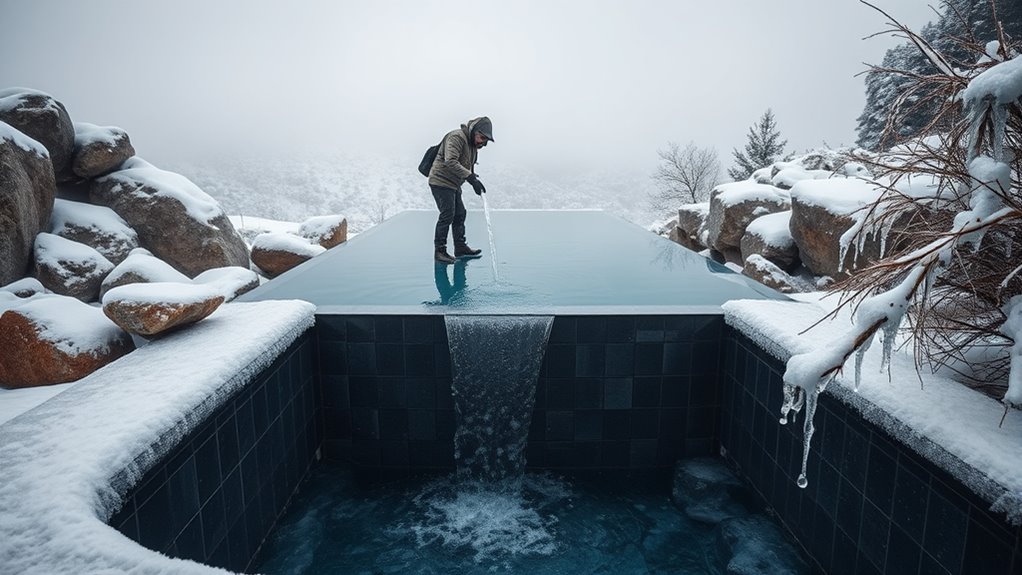
Have you ever wondered how to drain the trough of your infinity pool correctly? Start by turning off the pool’s pump and filter system to prevent water circulation. Next, locate the drain plugs at the lowest points of the trough—these are usually near the edges. Carefully unscrew or remove these plugs, allowing water to flow out slowly. Use a submersible pump or a siphon if needed to speed up the process, but avoid forcing water out too quickly, which could damage the structure. Make certain all drains are fully emptied to prevent leftover water from freezing and expanding during winter. Double-check that no residual water remains in the trough, as this will help protect your pool’s integrity through colder months. Proper winterization techniques are essential to maintain your pool’s longevity and performance over time.
Removing Water and Debris From the Trough

After draining the trough, it’s important to remove any remaining water and debris to prevent damage during the winter months. Use a clean, dry cloth or a sponge to soak up leftover water, paying close attention to corners and crevices. Remove leaves, dirt, and other debris with a soft brush or a handheld vacuum if needed. Clearing out debris prevents mold, algae, and potential clogging in the plumbing system. Inspect the trough for any dirt buildup or small debris that could cause issues later. Taking these steps ensures the trough stays clean and dry, reducing the risk of freezing damage and corrosion. Additionally, being aware of potential data privacy challenges related to pool equipment and automation systems can help you safeguard your property. Once you’ve thoroughly cleaned and dried the area, you’ll be ready to move on to the next steps of winterizing your infinity pool.
Protecting the Trough’s Plumbing System

To safeguard your trough’s plumbing system, you need to drain and blow out the lines to remove any remaining water. Adding antifreeze solutions guarantees that any residual water won’t freeze and cause damage during the cold months. Taking these steps helps keep your plumbing intact and ready for spring. Using antimicrobial properties in your antifreeze can also help prevent mold and bacteria buildup within the pipes during the off-season.
Drain and Blow Out Lines
Before winter hits, it’s essential to drain and blow out the lines of your infinity pool’s plumbing system. Start by turning off the pump and opening all drain valves to release remaining water. Use a garden hose to siphon out any water in the pipes. Next, employ an air compressor with a blowout plug to force compressed air through the lines. This process pushes out any residual water that could freeze and cause cracks. Be cautious not to use excessive pressure, as this could damage the plumbing. Focus on all lines, including skimmers, returns, and any auxiliary pipes. Once you’re confident the lines are clear and dry, you can seal the plumbing connections to prevent moisture intrusion during winter.
Add Antifreeze Solutions
Since water left in the plumbing can freeze and cause cracks during winter, adding antifreeze solutions is a crucial step in protecting your infinity pool’s trough. You’ll want to circulate non-toxic antifreeze through the plumbing system to prevent any remaining water from freezing and expanding. Imagine the clear liquid flowing through pipes, coating every nook and cranny, ensuring no water is trapped. Picture yourself pouring antifreeze into the skimmer or pump, then running the system to distribute it evenly. This process creates a protective barrier against the cold. To ensure effectiveness, verify that the plumbing connections are properly sealed before circulation.
Insulating the Trough Area
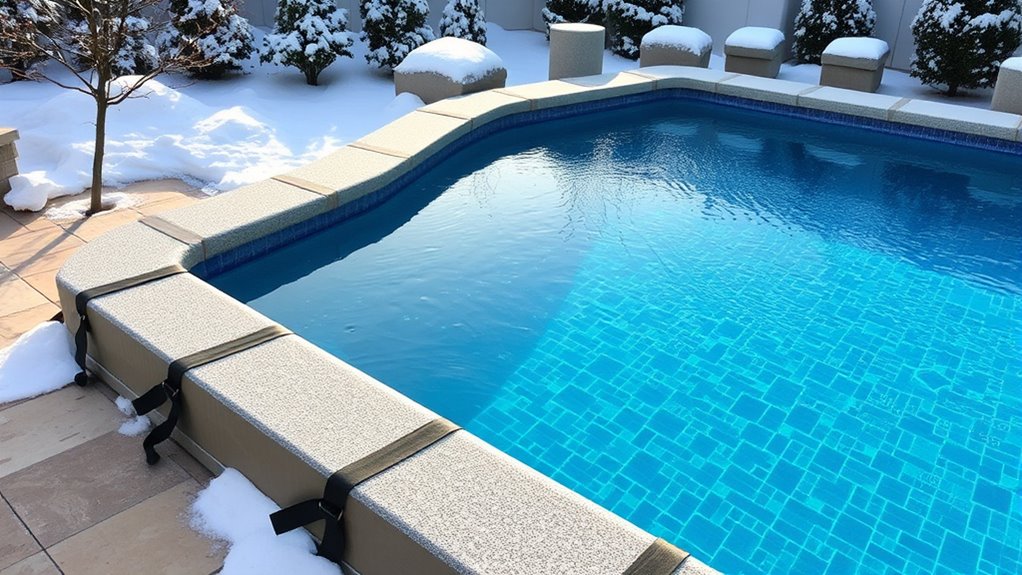
To keep your trough area well-insulated, start by applying foam insulation sheets around the edges. Make sure to seal any gaps and cracks to prevent cold air from entering. Additionally, consider using portable camping heaters designed for outdoor use to provide supplemental warmth during the coldest months. Finally, cover the entire area with a tarp or blanket for added protection during the winter months.
Use Foam Insulation Sheets
Using foam insulation sheets is an effective way to insulate the trough area of your infinity pool. These rigid sheets are easy to cut and fit precisely around the edges, creating a barrier against cold air and moisture. As you install them, you’ll notice how snugly they conform to the shape of the trough, preventing drafts and heat loss. The foam’s insulating properties help maintain water temperature and protect the structure during harsh winter conditions. Picture yourself securing the sheets firmly in place, ensuring they cover every vulnerable surface.
- Cutting the sheets to size for a perfect fit
- Securing them with waterproof tape or fasteners
- Ensuring no gaps remain for maximum insulation
Seal Gaps and Cracks
Have you checked for gaps or cracks around your infinity pool’s trough area? Inspect carefully, looking for any openings where air or water could seep in. Small cracks can worsen over winter, letting cold air invade and cause damage. Use a high-quality, waterproof sealant designed for outdoor pools to fill these gaps. Apply the sealant evenly with a putty knife or caulking gun, ensuring it penetrates fully. Pay special attention to joints, seams, and corners. Once sealed, smooth out any excess to create a tight barrier. Properly sealing gaps helps prevent drafts, reduces heat loss, and protects your pool structure during harsh winter conditions. Make this step a priority before moving on to other winterization measures. Monitoring for structural integrity is essential to ensure your pool remains in good condition throughout the season.
Cover With Tarp or Blanket
Wondering how to keep your infinity pool’s trough area warm during winter? Covering it with a tarp or blanket is an effective way to insulate and protect it from the cold. Choose a heavy-duty tarp or a dedicated pool blanket to create a barrier against wind and snow. This layer helps retain heat and prevents debris from settling into the trough, making spring cleanup easier. Make sure the cover fits snugly over the entire area, secured with weights or clips to prevent it from shifting. Visualize the tarp stretched tight over the trough, shielding it from icy gusts. Imagine snowflakes landing softly on the cover, melting slowly, and keeping the water beneath warmer and cleaner throughout the cold months. Using the right coverage ensures better insulation and prolongs the pool’s lifespan during harsh weather.
Covering the Trough for Winter
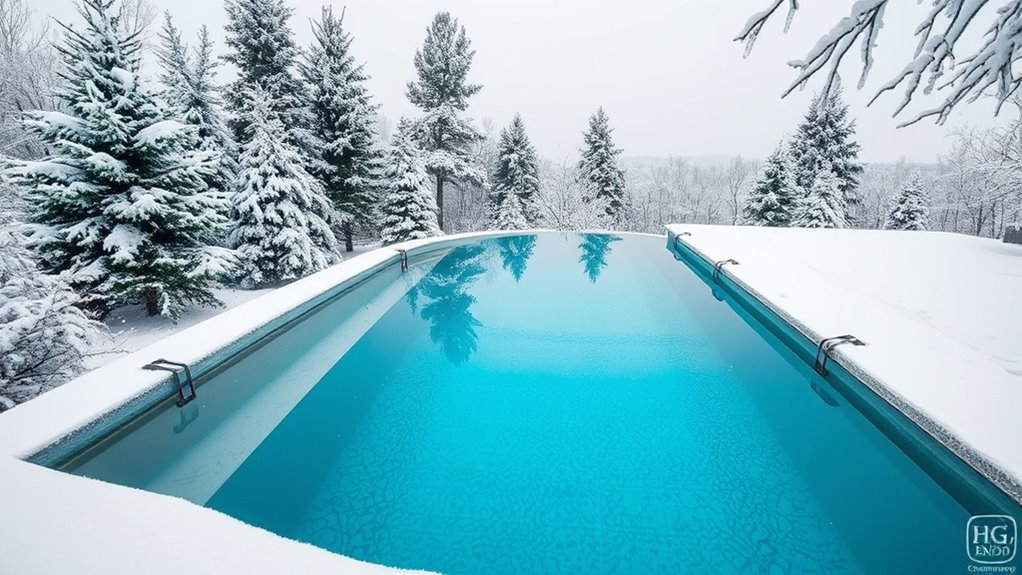
Covering the trough for winter is a crucial step to protect your infinity pool from debris, ice, and harsh weather conditions. You want to guarantee the trough stays clean and free from leaves, dirt, and pests that could cause damage or clog the filtration system. Use a sturdy, weather-resistant cover specifically designed for pools or troughs. Secure the cover tightly around the edges with clips or weights to prevent it from shifting in wind or snow. If your trough has a drain, close it to prevent water from accumulating underneath the cover. Consider adding an additional layer, like a tarp, underneath the primary cover for extra insulation. Proper coverage minimizes the risk of ice expansion and potential cracks, helping your pool stay protected throughout the winter months. Additionally, understanding the Dog breeds that make excellent family pets can help you decide if your dog might enjoy accompanying you during outdoor winter activities around your pool.
Checking and Maintaining the Water Level
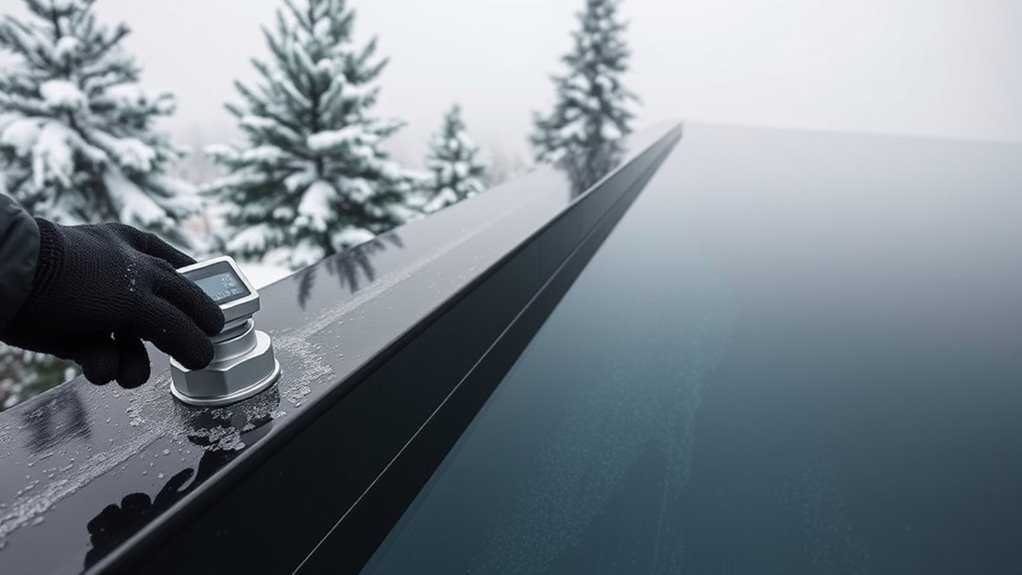
After securing the trough with a cover, it’s important to check and maintain the water level in your infinity pool. Ensure the water isn’t too low, which could expose the pump or cause damage, or too high, risking overflow when temperatures fluctuate. Use a reliable water level indicator or simply observe the water line against the trough’s markings. During winter, evaporation slows, but some water loss might still occur. Regularly topping off the water keeps everything balanced and prevents equipment from running dry. Picture the water shimmering just below the edge, ready to adapt to temperature changes without spilling over. Proper water testing ensures your pool’s chemical balance remains stable during the off-season. Visualize the clear water reflecting winter’s muted light; imagine gently adding water, watching the level rise steadily; envision the trough maintaining a perfect, balanced appearance.
Preventing Freezing Damage With Anti-Freeze Solutions

To protect your infinity pool from freezing damage, applying anti-freeze solutions is essential during cold months. You should add a pool-specific antifreeze, which is designed to prevent water inside pipes and equipment from freezing. Before pouring, ensure the pool is clean and the water levels are correct. Follow the manufacturer’s instructions carefully, typically adding the antifreeze through skimmers or dedicated lines. Don’t forget to circulate the solution throughout the plumbing system to reach all pipes and fittings. Using antifreeze helps prevent cracks, burst pipes, and costly repairs caused by ice expansion. Proper use of anti-freeze solutions keeps your pool’s plumbing intact and ready for spring reopening. Regular application before the coldest weather sets in is your best defense, especially since preventing cracks and leaks is crucial for maintaining your pool’s integrity.
Preparing the Surrounding Area for Spring Reopening

As winter ends and temperatures rise, it’s important to prepare the area around your infinity pool for spring reopening. Start by clearing away debris like fallen leaves, twigs, and dirt that have accumulated over winter. Trim back any overgrown plants or bushes that might have encroached on the pool area. Check the surrounding surfaces for cracks or damage caused by cold weather and repair them as needed. Finally, clean and inspect outdoor furniture, ensuring cushions and covers are in good condition for the warmer months. Visualize the scene: a tidy deck with polished furniture, freshly pruned greenery, and a clear, inviting pool ready for use. Proper preparation guarantees a smooth transition into spring and extends the life of your pool area.
Frequently Asked Questions
How Often Should I Inspect the Trough During Winter?
You should inspect the trough at least once a month during winter to guarantee it’s empty, clean, and free of debris. Regular checks help prevent ice buildup, which can damage the structure. If you notice any cracks or blockages, address them promptly. During colder months, especially in freezing climates, more frequent inspections are recommended to catch issues early and protect your infinity pool’s integrity.
Can I Leave the Trough Filled With Water All Winter?
Ever wondered if leaving your trough filled all winter is a good idea? It’s generally better to drain it to prevent freezing damage and ice expansion. If you keep it filled, the water can freeze and crack the trough or pipes. Instead, drain and clean it thoroughly, then cover or insulate to safeguard it from winter weather. This helps ensure your infinity pool stays in great shape for next season.
What Signs Indicate Freezing Damage to the Trough?
You’ll notice cracking or splitting in the trough’s material, which indicates freezing damage. If you see bulging or warping, that’s a sign the water froze and expanded inside. Also, look for water leaks or pooling around the trough, suggesting structural damage. Ice damage often causes discoloration or erosion on the surface. Regularly inspect your trough during winter, especially after cold snaps, to catch any issues early and prevent costly repairs.
Is It Necessary to Drain the Trough if Temperatures Stay Above Freezing?
If temperatures stay above freezing, you usually don’t need to drain the trough. However, it’s a good idea to monitor the weather closely. If there’s a sudden cold snap or unpredictable temperature drops, draining the trough can prevent potential freezing damage. Keep an eye on the forecast, and if unsure, consult your pool’s manufacturer or a professional to guarantee your trough stays in good condition through the winter.
How Do I Safely Remove Algae or Biofilm Buildup?
Removing algae or biofilm is like scrubbing away stubborn mold from a wall. You should start by brushing the affected areas thoroughly with a pool brush. Then, shock the pool with a strong chlorine treatment to kill remaining algae. Use a algae-specific cleaner or algaecide for stubborn spots. Run the pump and filter continuously, and regularly brush to prevent new buildup. This keeps your infinity pool crystal clear and inviting.
Conclusion
Now that you know how to winterize your infinity pool’s trough, you’re all set to keep it safe through the cold months. Just remember, even in this modern age, a little old-fashioned care—like checking on it regularly—can save you from costly repairs later. Think of it as giving your pool a cozy, wintery blanket, much like a knight preparing his steed for a long rest. With these steps, your trough will be ready for a grand opening come spring!
